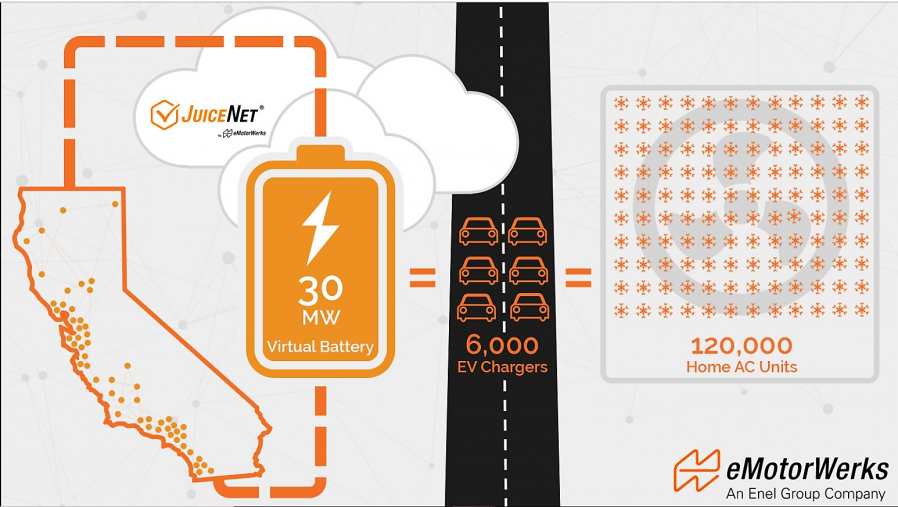Electric cars are going to crash the grid, right?
If everybody gets an EV we’ll have to build 100 more powerplants and it will cause our electric rates to triple, right? Not so fast.
Over 6,000 eMotorWerks residential JuiceBox and other JuiceNet-enabled chargers installed in California now make up a 30MW “virtual battery”. Locations are spread across the state and concentrated in the major population centers. By controlling them through the company’s cloud-connected JuiceNet software, and enrolling EV drivers to participate in rewards programs, eMotorwerks is delivering valuable grid services such as demand response capacity (up and down) on a daily basis across the state, with the capital outlay born by EV drivers instead of the utilities or energy storage developers.

The Enel subsidiary eMotorWerks is using its electric vehicle chargers to participate in California’s day-ahead markets. This network of connected devices is able to delay charging schedules based on a signal from the grid operator, while also considering drivers’ needs and enabling them to override the settings. EV owners earn compensation for participating in grid services, which now ranges between $40 to $80 per year, depending on their flexibility, and that number is growing as the program expands.
“We’re in growth mode,” said David Schlosberg, eMotorWerks VP for energy market operations. “Every time we get a new customer, we can revise our bid to reflect our growing capacity.”
It has the potential to open up a new financing structure for electric vehicle chargers, where vendors use future revenues to drive down the upfront cost of the infrastructure. The company also partners with energy providers, such as Sonoma Clean Power and Xcel Energy, and licenses its JuiceNet cloud-based platform, so they could deploy their demand response programs.
Interested JuiceNet customers living in participating California regions can sign up via the eMotorWerks Rewards program. Participants can also earn up to a $50 rebate on a charging station bought recently from eMotorWerks.com e-commerce site.
After signing up the system is automated, and doesn’t change the driver’s EV charging settings, providing override opportunity if the customer doesn’t want to be opted into a specific event. That’s necessary because there’s always a specific day now and then when you need more range than you do on a typical day. On those days you are allowed to opt out and have your car fully charged when you need it.

Valery Miftakhov, eMotorWerks CEO
“Having proved at scale capabilities that no other EV charging technology has accomplished, eMotorWerks is aggregating and bidding EV loads at the wholesale level,” said Val Miftakhov, CEO of eMotorWerks. “Our intelligent platform already delivers on grid integration, wholesale energy cost reduction and renewables integration with cost-effective load aggregation. It’s time for utilities around the country and the world to take advantage of these capabilities and help grow this virtual battery to support our shared electrification and decarbonization goals.”
When you really think about it, people who participate in Rewards are similar to people who rent out a room with Airbnb, Getaround, etc — turning an inefficiency or underutilized asset into savings or something of value for others. Basically, people are sharing their home chargers to make a bit of money, improve grid resilience, and reduce overall operational costs of managing the grid, ultimately saving all of us money and reducing GHG. It’s the EV home charging version of the new shared economy.
So much for the doom and gloom predictions on how electric vehicle adoption was going to crash the grid! This is a great example of how smart EV charging will actually be a asset to utilities, not the insurmountable problem that some anti-EV prognosticators have predicted. To learn more about how electric vehicles are turning into demand response capacity and how eMotorWerks plans to enter grid services markets check out this in-depth article from GreenTechMedia.com
Edit: eMotorWerks reached out to us to clairify the areas where customers can participate in the program:
Northern California: Only PG&E distribution service customers in SF Bay Area (South Bay, Peninsula, Marin, East Bay, not SF currently)
For Southern California: LA area (ex LADWP customers), not Ventura County
For San Diego: All SDG&E customers
